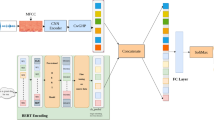Abstract
Making human–computer interaction more organic and personalized for users essentially demands advancement in human emotion recognition. Emotions are perceived by humans considering multiple factors such as facial expressions, voice tonality, and information context. Although significant research has been conducted in the area of unimodal/multimodal emotion recognition in videos using acoustic/visual features, few papers have explored the potential of textual information obtained from the video utterances. Humans experience emotions through their audio-visual and linguistic senses, making it quintessential to take the latter into account. This paper outlines two different algorithms for recognizing multimodal emotional expressions in online videos. In addition to acoustic (speech), visual (facial), and textual (utterances) feature extraction using BERT, we utilize bidirectional LSTMs to capture the context between utterances. To obtain richer sequential information, we also implement a multi-head self-attention mechanism. Our analysis utilizes the benchmarking CMU multimodal opinion sentiment and emotion intensity (CMU-MOSEI) dataset, which is the largest dataset for sentiment analysis and emotion recognition to date. Our experiments result in improved F1 scores in comparison to the baseline models.
Access this chapter
Tax calculation will be finalised at checkout
Purchases are for personal use only
Similar content being viewed by others
References
Wang A, Baoshan Sun RJ (2019) An improved model of multi-attention lstmfor multimodal sentiment analysis—proceedings of the 2019 3rd international conference on computer science and artificial intelligence 2019. Acm.org, https://dl.acm.org/doi/abs/https://doi.org/10.1145/3374587.3374606
Avots E, Sapin´ski T, Bachmann M, Kamin´ska D (Jul 2018) Audiovisual emotionrecognition in wild. Mach Vision Appl 30(5):975–985. https://doi.org/10.1007/s00138-018-0960-9, https://springerlink.bibliotecabuap.elogim.com/article/https://doi.org/10.1007/s00138-018-0960-9
Chandra E, Hsu JYJ (Nov 2019) Deep learning for multimodal emotion recognitionattentive residual disconnected rnn. 2019 International Conference on Technologies and Applications of Artificial Intelligence (TAAI). https://doi.org/10.1109/taai48200.2019.8959913, https://ieeexplore.ieee.org/document/8959913
Chatterjee J, Mukesh V, Hsu HH, Vyas G, Liu Z (Aug 2018) Speech emotion recognition using cross-correlation and acoustic features. 2018 IEEE 16th Intl Conf on Dependable, Autonomic and Secure Computing, 16th Intl Conf on pervasive intelligence and computing, 4th Intl Conf on Big Data Intelligence and Computing and Cyber Science and Technology Congress(DASC/PiCom/DataCom/CyberSciTech). https://doi.org/10.1109/dasc/picom/datacom/cyberscitec.2018.00050, https://ieeexplore.ieee.org/document/8511893
Dai W, Cahyawijaya S, Liu Z, Fung P Multimodal end-to-end sparse modelfor emotion recognition. https://arxiv.org/pdf/2103.09666.pdf
Devlin J, Chang MW, Lee K, Google K, Language A (2019) BERT: pre-trainingof deep bidirectional transformers for language understanding, https://arxiv.org/pdf/1810.04805.pdf
Khalil RA, Jones E, Babar MI, Jan T, Zafar MH, Alhussain T (2019) Speechemotion recognition using deep learning techniques: a review. IEEE Access 7:117327–117345 . https://doi.org/10.1109/access.2019.2936124, https:// ieeexplore.ieee.org/document/8805181
Poria S, Cambria E, Bajpai R, Hussain A (Sep 2017) A review of affective computing: From unimodal analysis to multimodal fusion. Inf Fusion 37:98–125 . https://doi.org/10.1016/j.inffus.2017.02.003, https://www.sciencedirect.com/science/article/pii/S1566253517300738
Qi H, Wang X, Hall F, Sitharama S, Cs I, Hall C, Chakrabarty K, Hall H Multisensor data fusion in distributed sensor networks using mobile agents. http://users.cis.fiu.edu/~iyengar/images/publications/data_ fusion_mobile_agents.pdf
Rao KS, Koolagudi SG (Jul 2013) Recognition of emotions from video using acousticand facial features. Signal Image Video Process 9(5):1029–1045. https://doi.org/10.1007/s11760-013-0522-6, https://springerlink.bibliotecabuap.elogim.com/article/https://doi.org/10.1007/s11760-013-0522-6
Zadeh A, Liang P, Vanbriesen J, Poria S, Tong E, Cambria E, Chen M, Morency LP (2018) Multimodal language analysis in the wild: cmu-mosei dataset and interpretable dynamic fusion graph, pp 2236–2246. https://www.aclweb.org/anthology/P18-1208.pdf
Author information
Authors and Affiliations
Editor information
Editors and Affiliations
Rights and permissions
Copyright information
© 2022 The Author(s), under exclusive license to Springer Nature Singapore Pte Ltd.
About this paper
Cite this paper
Khalane, A., Shaikh, T. (2022). Context-Aware Multimodal Emotion Recognition. In: Ullah, A., Anwar, S., Rocha, Á., Gill, S. (eds) Proceedings of International Conference on Information Technology and Applications. Lecture Notes in Networks and Systems, vol 350. Springer, Singapore. https://doi.org/10.1007/978-981-16-7618-5_5
Download citation
DOI: https://doi.org/10.1007/978-981-16-7618-5_5
Published:
Publisher Name: Springer, Singapore
Print ISBN: 978-981-16-7617-8
Online ISBN: 978-981-16-7618-5
eBook Packages: Intelligent Technologies and RoboticsIntelligent Technologies and Robotics (R0)




